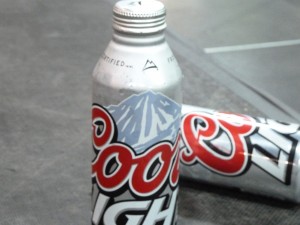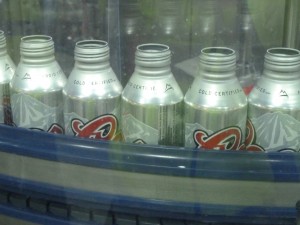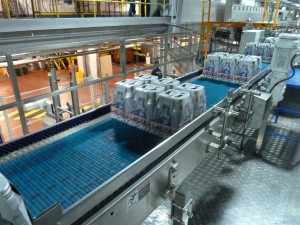I have a mildly complicated relationship with Molson.
This is probably because reality isn’t white hats and black hats. Craft beer isn’t Alan Ladd and Macro isn’t Jack Palance. Molson has a lot of strong points. They employ a number of immensely talented people, some of whom I like personally. My co-author Mark Murphy works out there, and he’s a heck of a guy. Also, most of the PR team people seem like nice folks who understandably remain vigilant about what they say around me.
They make beer extremely consistently in huge volumes, which is not an easy thing to do. Some of those beers are not to my taste, but you’ve got to respect that effort. I will admit that there’s nothing wrong with an ice cold can of Coors Light on a really hot day. You could do better, but you could also do worse. It was good enough for Burt Reynolds.
It’s also worth mentioning that I like their long term strategy with Six Pints. I believe the thinking is that promoting all beer is better than warring within the industry over a couple of points of market share. Plus, their management strategy seems to be that they should take the talented microbreweries they buy and throw resources at them to make their lives easier and their products better.
There are a lot of problems with Molson as well. They are owned by Americans, which I wouldn’t mind so much if the transitive property didn’t dictate that The Beer Store is currently experiencing 0% Canadian ownership. That’s not any one person’s fault, so it’s hard to get angry. It is problematic, though. You have to assume that they know there’s a coming push to review that situation and you have to assume they’ll fight tooth and nail to keep the 48% or so they own. They’re sort of obligated to. Doing anything else would be silly.
I think one of the reasons I have a decent working relationship with Molson is that I’m honest about the fact that they’re pretty largely a bunch of decent folks operating under a corporate mandate, and not some kind of dragon to be slain. Because of this, sometimes I get invited out to the Downsview plant to cover events and have a look at their new toys. The first time I went out there was to get a sense of the place. Craft brewing is all well and good, but a 10HL brewhouse is a human scale. To get a sense of what Molson does daily, you really need to stand next to a row of fermenters you could hunt for Red October in.That was not a press event. That was a personalized tour, which doesn’t seem to happen very much.
This was a press event. There were cameras and dignitaries and high ranking officials within the company. It was all to show off Project Acrobat. Project Acrobat is a 13.5 million dollar project that involves transforming an area of the Downsview Molson plant into the home for a new Krones flexible packaging line.
I think that for most of the journalists and dignitaries in attendance, the story was about the economic development. Molson employs 1400 people in Ontario alone, which is pretty neat. The Downsview plant produces 45% of their national volume. 13.5 million dollars is a lot of money. All of this is good news for the economy in a vague, “look, people are still investing locally” kind of way that is reassuring even though it’s not specifically obvious what it will do in the long term. In order for it to seem important, you need the specifics.

It’s a 473 ml package, essentially meaning it is the same size as a traditional can, but with a gimmick.
Here they are:
The flexible packaging line is a beast, according to a friend who works for Aagard Packaging. It’s all sleek stainless steel and precision calibrated automation. The installation took approximately 2.5 months beginning in February and included fixing up the environment the line would go in with new floors and stripped, cleaned and repainted ceilings. It can package in a number of different formats, including bottles, cans and the new widemouth aluminum bottles, which were on display at the event.
The automated 120-head filler can manage 300 units a minute. It is currently being operated on a single shift when needed, which can process 100,000 HL a year. According to Martin Gonzalez, who is currently in charge out at Downsview, if it went to three shifts, it could go as high as 350,000 HL annually.
When I saw the counter on the can QC, it had processed something like 160,700 units of which 54 were duds. That’s a success rate of something like 99.9997%. Jeff Nancekivell, who was giving me the detailed tour was quick to point out that that was “40 too many.”
That’s practically a Charles Bronson line. Jeff is awesome.
The press release and the dignitaries talk about innovation. That’s not entirely what this is about. This is about flexibility to respond to the market. If you have brands like Molson Canadian and Coors Light, which are key to your success, you can’t change them. The best you can do is figure out which way the public best enjoys them. Are bottle sales up over the last three months? This machine lets you produce more bottles. Are people buying the 355ml cans? Well, normally, with your canning line going at full tilt, you’d be hard pressed to keep them on the shelves. Not so in this case. Just use the flex line for more cans. It even introduces a third packaging option: the widemouth aluminum bottle. Maybe it will go over big with the public, maybe it won’t. The point is that the flex line ensures that even if it falls flat on its face, the production capacity won’t be wasted.
This is about Molson becoming lighter and quicker. They’ll be able to respond quickly and quietly to what people want based on sales data. In an era with giant monolithic brands, this is what catering to public taste looks like. It’s a clever way of maximizing the efficacy of your production capacity, leading presumably to less loss of volume through old product on shelves. It will save money and provide flexibility to move against AB InBev, who are their real competition. That’s why it’s important.

If the mayor drops by, people come to see the speech, even if they’re up in the rigging, so to speak.
On the widemouth bottles, I have an observation, and it is not really about the beer. I had Molson Canadian out of the widemouth bottles, and my feeling is this: You can actually drink out of them, which is what they’re designed for. You don’t get the metallic can taste you might from the lid of a can. The odd thing is that I, at least, felt compelled to screw the top back on to the bottle after each sip. I did it without thinking. I guess it might be a holdover from when you’re drinking a bottle of water. It’s a pretty odd sensation that I neither like nor dislike, but mention by way of pointing out that I think it means the packaging will sell.
People are used to the sensation of a 500ml screw top.

